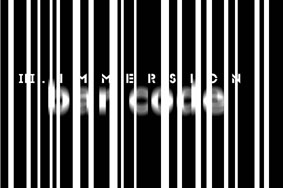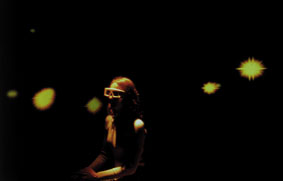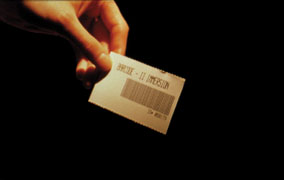


Darij Kreuh
BARCODE - III. immersion
Concept and technological design: Darij Kreuh
Sound construction: Rainer Linz
Software programming: Iztok Bajec
The digital processing of data enables various individual experiences of each viewer by establishing the real time link as the information highway connecting real space, virtual reality space and global net space. The self-organisation of the system (artificial intelligence), direct interactivity of real space with the synthetic one, the simulated model, the composition of acoustic elements in real time and fragmentation, the uninterrupted visualisation of a computer-generated sound picture of space and the openness of the system create chaotically structured complexity. Systems of identification, which proceed from the passive into the active state, represent new virtual borders and filters of the communication society in view of the systematic control and manipulation. As a result, each viewer develops perception of his digital body in the state of dying as his direct experience within which the entry to the system unconsciously transforms into the ritual of sacrifice.
The body mass provides the key information. Transformations of the user’s body mass (weight and height) into a digital form are presented as bar code prints. A laser scanner reads the bar code and transmits the data to the host computer, which then applies the data as a variable in the virtual sonic society (three-dimensional sonic organisms). The reaction to the variable is presented with the help of four loudspeakers, 4 projection canvases and the use of stereo glasses in real space.
I. Level - ENTRY
A system unit (a bar code station) which transforms analogue information into a digital one sets the entrance point of the entire installation. The unit consists of an ultra sound sonic measuring device of distance, a digital scale, a computer and a thermal printer. The user's two basic body parameters are measured &ndash height and weight. The computer is responsible for functional application of the data. The corresponding software processes and converts the data into a bar code, which is printed with the help of a thermal printer as identification data. The user can thereby use the data in the ensuing process.
II. Level - THE MAIN ROOM
The user, who has received his bar code and stereo glasses, enters the projection (virtual) space which is defined by four projection walls (4 x 4 x 3 m). In the center, there are two hand-held laser scanners set on special supports. The projection on the wall is undetached - a 360-degree projection of virtual environment which is filled with virtual sonic entities in motion.
OPERATING SYSTEM
The user reads his bar code with the help of a hand-held laser scanner. The computer converts the received data to a three-dimensional body and generates the image in the virtual sonic society. Reactions to the new body (the intruder) are represented by a changed position, volume and colour of sound of individual members, moreover, the sonic and visual picture of the entire society, which the user experiences as the symbiosis of sensory perception and immersion into the virtual, changes indirectly.
VIRTUAL SONIC SOCIETY
The society is a self-organised system in which the major principle of existence is the harmony of relationships and the balance of a system. Certain elements of the society are presented by three-dimensional amorphic forms (the white light), which transmit sounds and exist within virtual space. The position of the elements in space depends on their mass and the arrangement of the entire system which is orbital. The basic functions of each element are recognition of all members from the society, search of harmony within relationships among different masses as a condition of balance, perception of an intruder and its absorption. When a certain element detects an intruder (the green light), it absorbs it and thereby amplifies its mass and changes the position (the orbit) which represents the transgression to a higher life-cycle. Other members react to the change by re-arranging the position to achieve the balance (the identical number of members), which matches the new situation of the system. Triple surplus of the initial mass causes self-destruction of the element. Subsequent to a self-preserving system, the two nearest elements react to the sudden deficiency. They integrate into one and divide into three new elements with a specific initial mass (determined). Each initial element acquires a specific sound and its parameters change in accordance with the cycle in which a certain element abides. Each element can live up to three or four cycles according to the specific mass (the initial information of the system user).
III. Level - GLOBAL SPACE (VRML)
The third level is presented as a VRML model on the Internet. When the web user accesses a specific site, he can participate in the activity of the virtual community with the help of a specific programme and the VRML model.